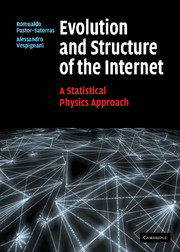Book contents
- Frontmatter
- Contents
- Preface
- List of abbreviations
- 1 A brief history of the Internet
- 2 How the Internet works
- 3 Measuring the global Internet
- 4 The Internet's large-scale topology
- 5 Modeling the Internet
- 6 Internet robustness
- 7 Virtual and social networks in the Internet
- 8 Searching and walking on the Internet
- 9 Epidemics in the Internet
- 10 Beyond the Internet's skeleton: traffic and global performance
- 11 Outlook
- Appendix 1 Graph theory applied to topology analysis
- Appendix 2 Interface resolution and router topology
- Appendix 3 Numerical analysis of heavy tailed distributions
- Appendix 4 Degree correlations
- Appendix 5 Scale-free networks: scaling relations
- Appendix 6 The SIR model of virus propagation
- References
- Index
5 - Modeling the Internet
Published online by Cambridge University Press: 12 January 2010
- Frontmatter
- Contents
- Preface
- List of abbreviations
- 1 A brief history of the Internet
- 2 How the Internet works
- 3 Measuring the global Internet
- 4 The Internet's large-scale topology
- 5 Modeling the Internet
- 6 Internet robustness
- 7 Virtual and social networks in the Internet
- 8 Searching and walking on the Internet
- 9 Epidemics in the Internet
- 10 Beyond the Internet's skeleton: traffic and global performance
- 11 Outlook
- Appendix 1 Graph theory applied to topology analysis
- Appendix 2 Interface resolution and router topology
- Appendix 3 Numerical analysis of heavy tailed distributions
- Appendix 4 Degree correlations
- Appendix 5 Scale-free networks: scaling relations
- Appendix 6 The SIR model of virus propagation
- References
- Index
Summary
At the large-scale level, the modeling of the Internet focuses on the construction of graphs that reproduce the topological properties observed in the AS and IR level maps. Representing the Internet as a graph implies ignoring the physical features of routers and connections (capacity, bandwidth, etc.), in a effort to gain a more simplified perspective that is still able to reproduce the empirical observations. From this perspective, Internet modeling initially relied on the traditional framework where complex networks with no apparent regularities were described as static random graphs, such as the model of Erdös and Rényi (1959). The graph model of Erdös–Rényi is the simplest conceivable one, characterized by an absolute lack of knowledge of the principles that guide the creation of connections between elements. Lacking any information, the simplest assumption one can make is to connect pairs of vertices at random with a given connection probability p.
Based on the random graph model paradigm, the computer science community has developed models of the Internet to test new communication protocols. The basic idea underlying the use of models to test protocols is that these should be independent (at least in principle) from the network topology. However, it turns out that their performance can be very sensitive to topological details (Tangmunarunkit et al., 2002a; Labovitz, Ahuja, Wattenhofer, and Srinivasan, 2001; Park and Lee, 2001). The use of an inadequate model can lead to the design of protocols that run very efficiently on the model, but perform quite poorly on the real Internet.
- Type
- Chapter
- Information
- Evolution and Structure of the InternetA Statistical Physics Approach, pp. 69 - 111Publisher: Cambridge University PressPrint publication year: 2004



